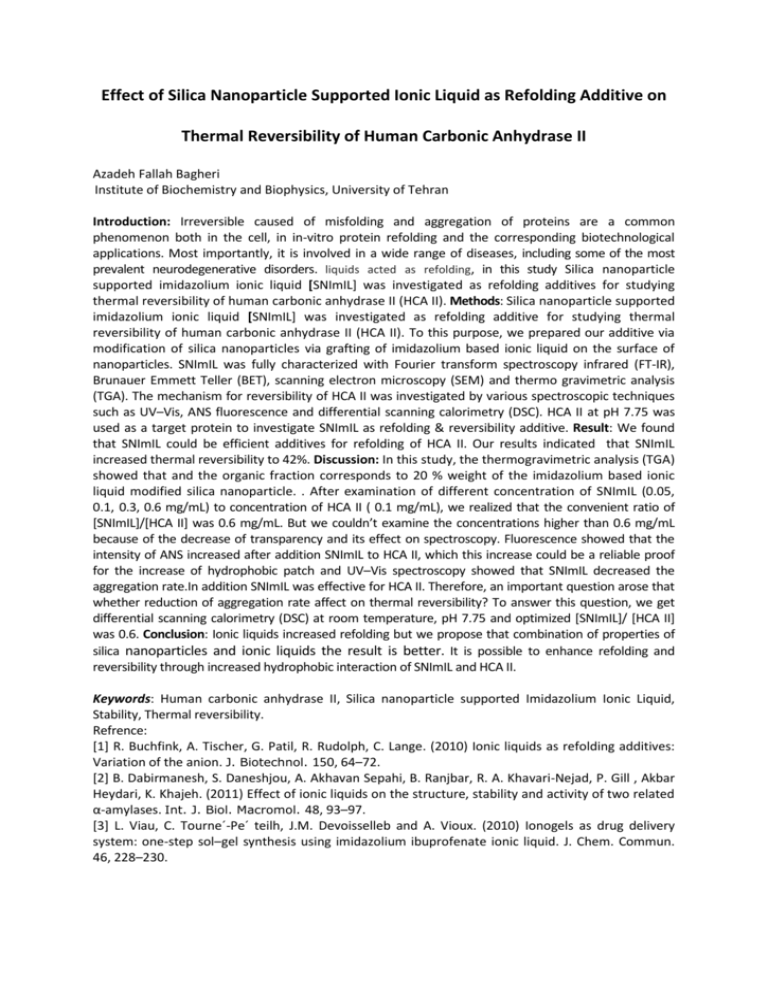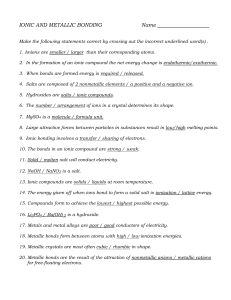Azadeh Fallah Bagheri - Institute of Biochemistry and Biophysics
advertisement

Effect of Silica Nanoparticle Supported Ionic Liquid as Refolding Additive on Thermal Reversibility of Human Carbonic Anhydrase II Azadeh Fallah Bagheri Institute of Biochemistry and Biophysics, University of Tehran Introduction: Irreversible caused of misfolding and aggregation of proteins are a common phenomenon both in the cell, in in-vitro protein refolding and the corresponding biotechnological applications. Most importantly, it is involved in a wide range of diseases, including some of the most prevalent neurodegenerative disorders. liquids acted as refolding, in this study Silica nanoparticle supported imidazolium ionic liquid [SNImIL] was investigated as refolding additives for studying thermal reversibility of human carbonic anhydrase II (HCA II). Methods: Silica nanoparticle supported imidazolium ionic liquid [SNImIL] was investigated as refolding additive for studying thermal reversibility of human carbonic anhydrase II (HCA II). To this purpose, we prepared our additive via modification of silica nanoparticles via grafting of imidazolium based ionic liquid on the surface of nanoparticles. SNImIL was fully characterized with Fourier transform spectroscopy infrared (FT-IR), Brunauer Emmett Teller (BET), scanning electron microscopy (SEM) and thermo gravimetric analysis (TGA). The mechanism for reversibility of HCA II was investigated by various spectroscopic techniques such as UV–Vis, ANS fluorescence and differential scanning calorimetry (DSC). HCA II at pH 7.75 was used as a target protein to investigate SNImIL as refolding & reversibility additive. Result: We found that SNImIL could be efficient additives for refolding of HCA II. Our results indicated that SNImIL increased thermal reversibility to 42%. Discussion: In this study, the thermogravimetric analysis (TGA) showed that and the organic fraction corresponds to 20 % weight of the imidazolium based ionic liquid modified silica nanoparticle. . After examination of different concentration of SNImIL (0.05, 0.1, 0.3, 0.6 mg/mL) to concentration of HCA II ( 0.1 mg/mL), we realized that the convenient ratio of [SNImIL]/[HCA II] was 0.6 mg/mL. But we couldn’t examine the concentrations higher than 0.6 mg/mL because of the decrease of transparency and its effect on spectroscopy. Fluorescence showed that the intensity of ANS increased after addition SNImIL to HCA II, which this increase could be a reliable proof for the increase of hydrophobic patch and UV–Vis spectroscopy showed that SNImIL decreased the aggregation rate.In addition SNImIL was effective for HCA II. Therefore, an important question arose that whether reduction of aggregation rate affect on thermal reversibility? To answer this question, we get differential scanning calorimetry (DSC) at room temperature, pH 7.75 and optimized [SNImIL]/ [HCA II] was 0.6. Conclusion: Ionic liquids increased refolding but we propose that combination of properties of silica nanoparticles and ionic liquids the result is better. It is possible to enhance refolding and reversibility through increased hydrophobic interaction of SNImIL and HCA II. Keywords: Human carbonic anhydrase II, Silica nanoparticle supported Imidazolium Ionic Liquid, Stability, Thermal reversibility. Refrence: [1] R. Buchfink, A. Tischer, G. Patil, R. Rudolph, C. Lange. (2010) Ionic liquids as refolding additives: Variation of the anion. J. Biotechnol. 150, 64–72. [2] B. Dabirmanesh, S. Daneshjou, A. Akhavan Sepahi, B. Ranjbar, R. A. Khavari-Nejad, P. Gill , Akbar Heydari, K. Khajeh. (2011) Effect of ionic liquids on the structure, stability and activity of two related α-amylases. Int. J. Biol. Macromol. 48, 93–97. [3] L. Viau, C. Tourne´-Pe´ teilh, J.M. Devoisselleb and A. Vioux. (2010) Ionogels as drug delivery system: one-step sol–gel synthesis using imidazolium ibuprofenate ionic liquid. J. Chem. Commun. 46, 228–230.






